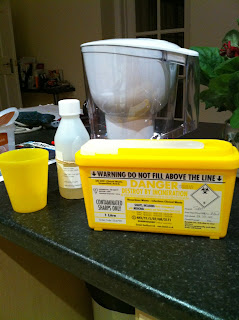On Thursday 28 October 2010, confident that the self-administered injections of prescribed wonderstuff would by now have bolstered my immune system, I ventured out for lunch in Richmond. My companion was the same person with whom I had eaten on 3 September, the day of the routine blood test that had led to diagnosis and the shifting of ground beneath my unsuspecting feet. On that earlier occasion we had sat outside in blazing sunshine but now the weather, though dry and pleasant, had an autumnal chill and we sat inside, eating a “surf ’n’ turf” combination of fish cakes and pork loin, washed down in my case with considerably less red wine than I would have enjoyed a few weeks previously. I had hair then too.
If the food combo sounds odd, it may help if I tell you that the restaurant was a tapas bar, where such counter-intuitive gustatory marriages are easier to find and, I dare say, to digest. The authentic decor—acres of ceramic tiles in rich browns and reds—helped put the imagination in Iberian mode ready for the food.
As my companion is one of my employers, much of our conversation centred around professional topics, including how my illness and treatment would affect my work over the coming weeks and months. It ranged far and wide over other matters as well, including the state of the economy and the strange habits of lawyers (I used to be one and my friend used to work on the financial side of a large firm of solicitors).
Before eating, having a few moments to fill, I had checked out a possible new dental practice to register with, mindful that good oral health was even more important now that my immune system was doing an impression of a roller coaster. It was all a bit bright and shiny for me though, with an emphasis on creating the perfect smile that led me to think that it would be more interested in selling me expensive falsies than in the basics of tooth care. A far cry from the traditional practice in the front room of a private house that has been the norm for me over the years and so I shelved the issue of finding a new dentist for now.
After lunch I managed to buy some new pyjamas in M & S, this after months of searching for the right combination of styles and size.
Fortified by food, relaxed by wine and conversation and pleased with my new jim-jams, but not yet weakened by chemo, I walked home to Twickenham to find that a friend had brought over a home-made tarte Tatin for the family to enjoy. And so we did, with vanilla ice cream bien entendu.
 |
| The tarte Tatin. Created in the 1890s at L'Hôtel Tatin in Lamotte-Beuvron in the Loir et Cher département of north central France, when it was run by two sisters called, er, Tatin. Whether originating from design or, as the various stories have it, accident, the dish is an enduring favourite. You can read the hotel's own account (French alert) on its website. |
Talking of chemo, one of the online discussion boards that I subscribe to was dominated by talk of bendamustine, an “alkylating agent” developed in East Germany around fifty years ago and increasingly adopted in the West over recent years. It seems to hold great promise as a chemo drug with fewer side effects and less toxicity than some current treatments, but it needs more evaluation before being approved for treatment of WM in the UK. The Americans are already using it as a treatment of choice, so I hope we get our act together soon. This view is of course offered with the usual caveats (i.e. I am not medically or scientifically qualified).
 |
| The Berlin Wall, whose breach allowed more than just Trabants to reach the West. |
It was as well that I enjoyed my food on this particular day, as round 2 of chemo was due the next…




